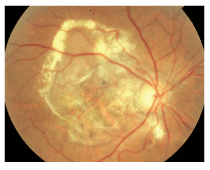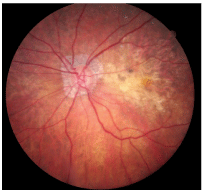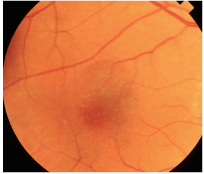 Age-related macular degeneration (AMD) is a leading cause of vision loss in the elderly.1 AMD is largely characterized by a progressive deterioration of the retinal pigment epithelium (RPE) and the photoreceptors.
Age-related macular degeneration (AMD) is a leading cause of vision loss in the elderly.1 AMD is largely characterized by a progressive deterioration of the retinal pigment epithelium (RPE) and the photoreceptors.
Although the exact pathogenesis of AMD is still unknown, researchers have identified various risk factors. These risk factors include age, ethnicity, gender, genetics, cardiovascular disease, smoking and sun exposure.1-3 Cumulative oxidative stress may also play a contributory role by leading to apoptosis of the photoreceptor cells.3,4
Several studies have demonstrated the benefits of nutritional supplements, such as antioxidants, for patients with existing AMD.4-8 For example, nutritional supplements have been associated with a decline in the progression of the disease.7,8 We will look at some studies here.
AREDS

1. The end stage of exudative AMD is associated with a fibrovascular star.

2. This patient demonstrates the end stage of non-exudative AMD. Note the associated severe retinal atrophy that appears in a geographic pattern.

3. This patient shows signs of early AMD associated with drusen and areas of retinal pigment epithelium disruption.
The majority of current nutritional guidelines for managing patients with AMD come from the Age-Related Eye Disease Study (AREDS).8-10
AREDS was the first large-scale, randomized, double-masked clinical trial that answered the question: What effect do antioxidants have on the progression of AMD?
AREDS included nearly 4,000 subjects from 11 centers. The results showed that high intake levels of antioxidants and zinc lowered the risk for disease progression by 25% in patients with intermediate or advanced AMD (figures 1 and 2).7 Additionally, these nutritional supplements reduced the overall risk of moderate vision loss by 19%.7
But, remember that these results were only apparent in patients with intermediate or advanced AMD. Due to the slow, progressive nature of early AMD, nutritional supplements were unable to show any statistical benefit for patients in less advanced stages of AMD (figure 3).
Today, the AREDS formula is widely available through a variety of companies, and is commonly used to manage patients with AMD.
Beyond AREDS
Since AREDS results were published, researchers have focused greater attention on the ocular health benefits of other nutrients.5,10-15 Several smaller studies have demonstrated the effects of lutein, zeaxanthin and omega-3 fatty acids.
Lutein and zeaxanthin are carotenoids that selectively accumulate within the macular pigment. These carotenoids are exclusively derived from nutritional origin, and are found in greater quantities in leafy, green vegetables. Heightened dietary intake of lutein and zeaxanthin is associated with increased macular pigment density.10 Thus, carotenoids may serve as a preventive mechanism against AMD, to optimize ocular health.10
Lutein absorbs blue light, quenches free radical formation, and diminishes oxidative retinal stress. In 1994, Johanna Seddon, M.D., and associates concluded that 6mg of lutein per day reduced the risk for developing AMD by up to 43%.6
In 2004, Stuart Richer, O.D., Ph.D., and associates reported results of the Lutein Antioxidant Supplementation Trial (LAST).10 This 12-month study evaluated the effects of lutein alone and/or in combination with antioxidants and other vitamins and minerals on visual function in 90 male patients with atrophic AMD.10
Results showed that supplementation with lutein alone or in combination with other nutrients significantly improved visual function and macular pigment density.10
Omega-3 is a polyunsaturated fatty acid that is obtained from oily fish, such as salmon, as well as flaxseed and walnuts. High concentrations of these polyunsaturated fatty acids are found in the outer segment membranes of photoreceptors, and have both a structural and functional role.
The anti-angiogenic and anti-inflammatory properties of omega-3 fatty acids have been inversely associated with the risk of developing advanced AMD.16,17 In patients with non-exudative AMD, these anti-angiogenic properties protect against progression to the exudative form.16,17
In 2007, the Taurine, Omega-3 fatty acids, Zinc Antioxidant, Lutein (TOZAL) Study reported the effects of omega-3 fatty acids and other nutrients on mitigating the progression of AMD.11
Thirty-six patients from five evaluation sites participated in the TOZAL study. Visual acuity stabilized or improved in two-thirds of the patients who took nutritional supplements that consisted of omega-3 fatty acids and antioxidants.11
In 2006, researchers began enrolling subjects with intermediate or advanced AMD for AREDS 2. This new study will evaluate the effects of lutein, zeaxanthin and omega-3 long-chain polyunsaturated fatty acids (docosahexaenoic acid, or DHA, and eicosapentaenoic acid, or EPA) on disease progression.18,19
AREDS did not evaluate the effects of these carotenoids on AMD progression, since lutein and zeaxanthin were not commercially available when the study began. Additionally, due to the undesirable side effects associated with a high intake of some antioxidants and minerals, AREDS 2 will refine the existing AREDS formula.
High levels of beta-carotene have been linked to an increased incidence of lung cancer among heavy smokers.8,20 Also, high volumes of zinc have been associated with genitourinary disorders and gastrointestinal disorders.20
AREDS 2 will evaluate the impact of lutein, zeaxanthin and omega-3 long-chain polyunsaturated fatty acid supplements on the development of advanced AMD. Additionally, the study will assess the effects of reducing zinc and eliminating beta-carotene on the progression of AMD. Currently, AREDS 2 is still recruiting participants.
During the last two decades, we have gained a considerably better understanding of age-related macular degeneration. A growing body of evidence supports the hypothesis that nutritional supplementation may serve as a mainstream preventive management strategy. As the population ages, the number of patients with AMD will continue to increase. The next research frontier will further advance our complete understanding of AMD and may clarify the true role of nutritional supplements in helping to treat or prevent this disease.
1. National Eye Institute. Vision in the
2. The Eye Disease Prevalence Research Group. Cause and prevalence of visual impairment among adults in US. Arch Ophthlamol 2004 Apr;122:477-85.
3. Smith W, Assink J, Klein R, et al. Risk factors for AMD. Ophthalmology 2001 Apr;108(4):697-704.
4. Hogg R, Chakravarthy U. AMD and micronutrient antioxidants. Curr Eye Res 2004 Dec;29(6):387-401.
5. Allen MJ, Jarding JB, Zehner R. Macular degeneration treatment with nutrients and micro current electricity. J Orthomolec Med 1998;13:211-14.
6. Seddon JM, Ajani UA, Sperduto R. Dietary carotenoids, vitamins A, C, and E, and advanced AMD: Eye Disease Case Control Study. JAMA 1994 Nov 9;272(18):1413-20.
7. AREDS Group. A randomized, placebo-controlled, clinical trial of high dose supplementation with Vitamin C and E, beta carotene, and zinc for AMD and vision loss: AREDS report no. 8. Arch Ophthalmol 2001 Oct;119(10):1417-36.
8. AREDS Group. A randomized, placebo-controlled, clinical trial of high dose supplementation with Vitamin C and E, beta carotene, and zinc for AMD and vision loss: AREDS report no. 9. Arch Ophthalmol 2001 Oct;119(10):1439-52.
9. Clemons TE, Chew EY, Bressler SB, et al. Research Group National Eye Institute Visual Function Questionnaire in the Age-Related Eye Disease Study (AREDS): AREDS report no. 10. Arch Ophthalmol 2003 Feb;121(2):211-7.
10. Richer S, Stiles W, Statkute L. Double-masked, placebo-controlled, randomized trial of lutein and antioxidants supplementation in the intervention of atrophic AMD: Veterans LAST study. Optometry 2004 Apr;75(4):216-30.
11. Cangemi FE. TOZAL Study: An open case control study of an oral antioxidant and omega-3 supplement for dry AMD. BMC Ophthalmol 2007 Feb 26;7:3.
12. Kvansakul J, Rodriguez-Carmona M,
13. Sartore M, Fregona I, Piermarocchi S, et al. Effects of short-term supplementation with carotenoids and antioxidants on visual acuity and visual function in AMD. Presented at The Association for Research in Vision and Ophthalmology (ARVO)
14. Pratt VP, Richer S, Tornable P, et al. Macular pigment density negatively correlated with glare recovery in female patients with normal acuity. The Association for Research in Vision and Ophthalmology (ARVO)
15. Beatty S, Boulton M, Henson D. Macular pigment and AMD. Br J Ophthalmol 1999 Jul;83(7):867-77.
16. SanGiovanni JP, Chew EY. The role of omega-3 long-chain polyunsaturated fatty acids in health and disease of the retina. Prog Retin Eye Res 2005 Jan;24(1):87-138.
17. Seddon JM, George S, Rosner B. Cigarette smoking, fish consumption, omega-3 fatty acid intake, and associations with age-related macular degeneration: the US Twin Study of Age-Related Macular Degeneration. Arch Ophthalmol 2006 Jul;124(7):995-1001.
18. Age Related Eye Disease Study 2. Available at: www.areds2.org (Accessed November 19, 2007).
19. National Eye Institute: AREDS 2. Available at: www.nei.nih.gov/areds2 (Accessed November 19, 2007).
20. Smigel K. Beta carotene fails to prevent cancer in 2 major studies: CARET intervention stopped. J Natl Cancer Inst 1996 Feb 21;88(3-4):145.











